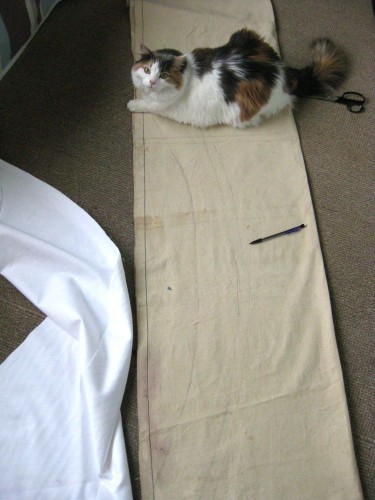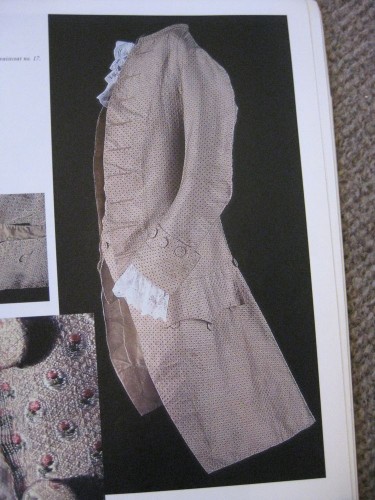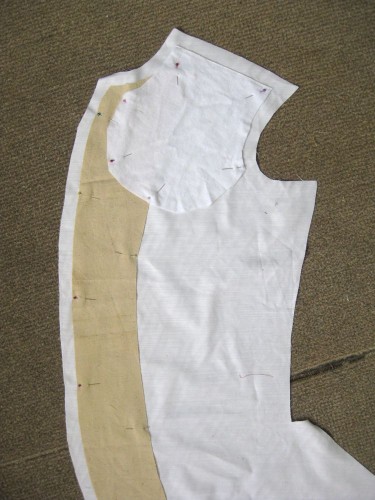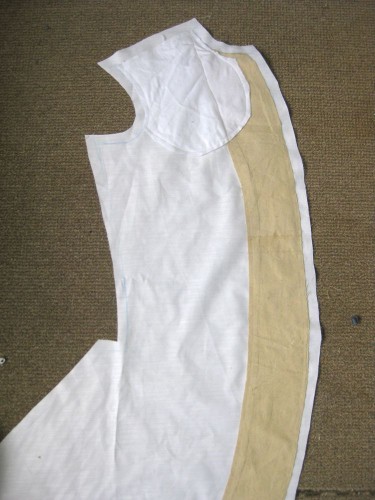Remember how I cut out and started an 18th century man’s jacket? Well, I did, and it worked, and then I lost the sleeves, but I can’t for the life of me remember what I used as a pattern!
So when I re-started a 1770s mans ensemble to go with the Lady Anne Darcy dress, I really had to re-start, and find a whole new pattern.
This time I used the 1765-1790 man’s suit pattern from Colonial Williamsburg’s Costume Close-Up: Clothing Construction and Pattern. It’s based on this suit:
The pattern is relatively simple: a front and back piece, two piece sleeves, cuffs, collar, pocket flaps, and some interfacing and padding.
I found the interfacing and padding diagram particularly useful. I used an old linen with a bit of staining for my interfacing, and a bit of flannel for the padding in the chest.

Marking and cutting out my interfacing strip. You can see the stains on the fabric. And Felicity being cute.
I pinned my padding and the interfacing on and basted them down at the same time.
A lot of padding wasn’t really necessary: Daniil has a great full chest, and the pigeon look isn’t so popular with men nowadays anyway.
I just used a sewing machine for all the basting and sewing of the interfacing (and most of the rest of the jacket). The visible parts are handsewn, but as this was my ‘trial’ jacket, I don’t feel too bad about not being super historical.
The white that you are seeing is the lining, a great diagonally ribbed cotton that I picked up a LOT of for $4 a meter. I’ll blog more about it tomorrow.
I ended up doing quite a bit of adaption to the pattern once I fitted it on Daniil. The arm-scythes were way too narrow, and the chest and back weren’t narrow enough, so I took it and the chest in quite a bit.





That pattern is really great! I made a frock coat from it, semi-successfully (something is up with my back pleats…. still haven’t figured out exactly what went wrong. 🙂
Here are some photos. It could accompany your recent (and very lovely) yellow dress!
http://www.flickr.com/photos/zoh/sets/72157610697845873/
I drafted this exact frock coat from the same book to make for my son last year.
Laurie
Cool. How did your version work out?
Pretty well. I thought I messed it up horribly because of how the tails are cut across then lie down. They don’t look anything at all like what the Colonial Williamsburg interpreters are wearing. So I went to the head tailor for help. He is reknown for his expertise. He said I did a good job with the coat and asked what the problem was. When I showed him he said it’s simply a different style of tail. The one from Costume Close Up (which he helped to write) is mid-18th century. The ones the interpreters wear on the streets are 1770’s. I wailed that I made my son out of fashion but he said there were those who continued to wear the older styles in the 1770’s, so we were still period accurate. At least now I can date frock coats!
Here are some pictures of my son wearing it last June. I made the coat last October. It’s taken a bit of a beating in a lot of washings but is rather durable. It’s made from 100% linen, but is a bit thicker type of linen than I prefer. This coat is made for him to run around CW in, not for an exhibition piece, so I try to make his things durable period accurate.
http://teacupsamongthefabric.blogspot.com/2011/07/under-redcoat-in-costume.html
Laurie
I just love your cat! My family has a lot of cats, and it makes me laugh when you post pictures of Felicity in the middle of your work, because I’ve been through the exact same thing. 🙂
I really like the jacket too. The pictures of it at the talk were fantastic! I usually only like 19th and early 20th centuries for men’s clothing, bit the 18th century jackets are actually pretty cool looking.
What a great jacket! I have a thing for 18th century men’s clothes, and one of these days I’ll make one of those jackets for myself. Have to finish the waistcoat though. I had a wee problem with adapting the pattern to accommodate my chest and now I’m avoiding it because I recently bought Patterns of Fashion 2 and got quite excited about it.
I would love to embroider all over the jacket and the buttons, I have just purchased some wooden button moulds from the States, to have a go at doing some fabric covered buttons. Can’t wait till they arrive. Its funny it so often seems we are on kind of similar tracks, I did a post about fabric covered buttons last night, with pictures of men’s jackets from the late 1700’s. You must think I am some weird kind of stalker, I’m comng to get you, hee hee ha ha, coming to take you away!
Seriously though I love the jacket shape and cut, can’t wait to see it come together, what was the project you had set the blue satin aside for?
What book is this from?
It’s in the post 😉
Another question please, without the lining (roughly) how much fabric did the coat use? I need to know how much to get, I can’t even guess.
I think it was 3.5m, but I really don’t remember exactly.
Considering scaling down your coat pattern for a coat for a leprechaun doll i’m making.
And of course I would discover this whole series of posts of yours *after* I finished my coat. Sigh. Isn’t that how it always works?
Yes it is! Still, your justacorps look amazing!
I’m a reenactor, and I was wondering if you decide to make another one of these any time soon, would you please make a video? I have a fashion blog, and I will surely post about it. I am an amateur to sewing and not completely understanding of how to read patterns alone yet, but would absolutely love a video explaining and showing some of this! Thanks!
Hello, where can I get this sewing pattern please I have looked everywhere and I can’t find one. I’m from the UK. Thanks Scott.
Leimomi:
Thank you so much for posting this. I’m making a period costume for my son this Halloween and your experience and illustrations have been an excellent guide for me (being such a novice).
By the way, your cat looks a lot more helpful than mine. My cat, Peaches, is only interested in helping me remove stitches.
-Jack